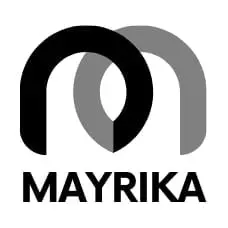Cleaning your hard anodized cookware is important to ensure that it doesn’t have any food or other residue leftover from cooking.
This will help keep the cookware’s exterior looking nice and prevent corrosion if you let a build-up of food residue on the surface for too long.
Interior cleaning is also important because this is where you prepare all your meals. Hence, there may be some bacteria left behind after washing dishes.
Combined, these two things make for a healthy kitchen, leading to many happy years using your pots and pans.
Cleaning your cookware can be a pain, especially if you have hard-anodized cookware. The good news is, that some tricks will make it much easier to clean up after dinner.
Here’s how to clean hard anodized cookware exterior and interior!
Hard anodized cookware
Anodized cookware may seem new to you, but it’s been around for years. Hard-anodized cookware is made by anodizing the inside and outside layers of aluminum with a coating of aluminum oxide.
The benefits of hard anodized cooking ware are that it heats quickly and evenly, is strong and durable, doesn’t have metal handles to get hot from the stovetop, or off-gas toxic chemicals into food while cooking.
It also has a non-stick surface on the inside, which makes cleanup quick and easy! One advantage to this type of pot is that emulsions may start to form when food cooks in it for too long.
Hard-anodized aluminum, also known as anodized aluminum, is composed of aluminum that has been doped with silicon gas. It is a dielectric or insulating surface where the electric conductivity has been reduced to very low levels.
Hard-anodized cookware offers improved durability and scratch resistance over traditional anodized cookware because of the even thickness of the coating on both its interior and exterior.
Hard-anodic coatings are safe for home cooks who care about health because they do not contain PTFE or PFOA (chemicals that release fumes during cooking).
It’s a manufacturing process that starts with a thin aluminum or porcelain-covered stainless-steel liner. That lining is on the inside of the cooking pans, between an outer glassy surface and the aluminum core.
The outside of this hard-anodized cookware looks like ceramic, but it’s not. It’s just something called “glass coating.” Ceramic would be much heavier than glass coating because, to get hard anodization, there has to be some aluminum in it.
How to clean hard anodized cookware exterior?
Cleaning hard anodized cookware is a laborious task, but it doesn’t have to be. Keep reading! and try these tips and tricks!
Here’s what you’ll need: water, dish soap, baking soda, vinegar, sponge, Bar Keepers Friend powder, olive oil, or coconut oil.
Cleaning hard anodized cookware exterior can be a challenge. If you are looking for the best way to clean it, try these tips and tricks:
- Boil water in your pot or pan
- Add dish soap (Dishwasher detergent is recommended because of its high alkaline content)
- Pour some baking soda and vinegar into the boiling water
- Let boil for 10 minutes; then let cool
- Scrub with a sponge
- Rinse off all of the cleaning solutions
- i) For higher-end brands: use their cleaner ii) For lower-end brands: Use Bar Keepers Friend powder
- Polish with cooking oil such as olive oil, coconut oil
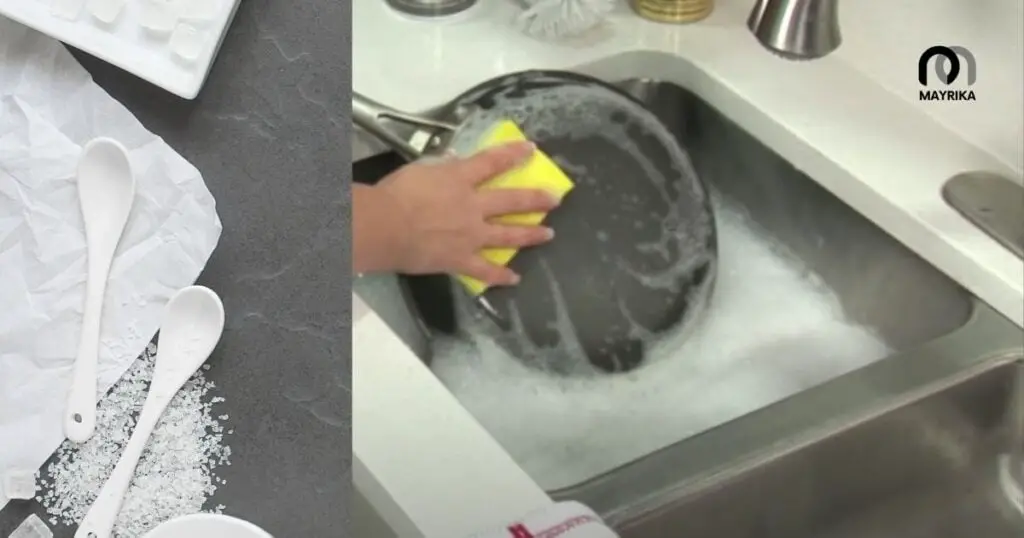
The right cleaning methods
Why can’t I use a soapy sponge on all other kitchenware, but is it the only way to clean hard anodized?
Soapy water and sponges are harsh on pots and pans. Regular scrubbing breaks down the non-stick properties of hard-anodized cookware, white-paneled dishwashers, and Pearl Stone surfaces in your home.
So, to avoid this wear and tear installation of lasagna-style dinner as it embeds into these surfaces over time, dry wipes are preferred for cleaning hard anodized cookware followed by rinsing.
Rinse off the cookware with cold water
Rinse the cookware with cold water. This will stop any cooking progress and provide an opportunity to clean the cookware.
This is a good idea for all cookware but can be especially important for pots with something in them like soup, chocolate, tomato sauce, or anything you don’t want to get on your walls or ceiling from boiling over!
You don’t need soap because it won’t help unless there’s food or grease in the pot. Rinse off what you can with just water.
Boil water in your pot or pan
You’ll need to fill your pot or pan with water, bring it to a boil, and then let the water cool for about five minutes before pouring it onto your skillet. Since anodized aluminum is acidic, the boiling water will neutralize the pan’s surface, making it shinier and considerably easier to scrub off rust spots.
After you’ve poured out your boiling water (remembering not to pour all of it in one spot!), use a sponge or rag soaked in a soapy dish detergent to clean any cooking grease off as well as what remains.
When you initially clean after cooking – dish soap won’t harm anodized aluminum, but you may want fewer suds than usual because there’s no danger of creating streaks.
Add dish soap
Adding dish soap to a pot with water will cut through the grease and oil on your pan. This is important because the coating on the hard-anodized exterior is not always non-stick.
You’ll need a large pot of boiling water with one or two tablespoons of dishwasher detergent and soapy water.
There are various preservatives combined with dishwasher detergent instead of just salt that can be damaging to aluminum. To avoid corrosion, it is recommended not to use more than 2 tablespoons in 12 liters of water.
The different brands of dishwasher detergents have varying alkalinity levels, so you want one that’s on the lower end containing something close to 14-50pH as a maximum, while anything over 14-51pH contains additives that could be detrimental if left on for too long and make scrubbing is more difficult.
Baking soda and vinegar in the boiling water
Baking soda can be used safely on cleaning the hard-anodized exterior, and it is one of the standard cleaners for outdoor cooking vessels.
Just make sure to clean off any residue before heating food in it! Baking soda itself actually won’t attack or corrode the surface since it’s a salt (NaHCO3).
Vinegar can weaken some types of cleansers, so you should first test in a small area on the outside. Use a stainless-steel scrub bucket and scouring pad for scrubbing grubby spots.
Many people had success when they used baking soda and vinegar in the boiling water to clean their hard-anodized exterior.
This is because the acid in the baking soda combined with the salt in the vinegar helps break down any stubborn baked-on spills or stains while also exfoliating your surface!
If you’re a dishwasher and you’re looking for that extra boost, make sure your detergent has some lemon juice as well.
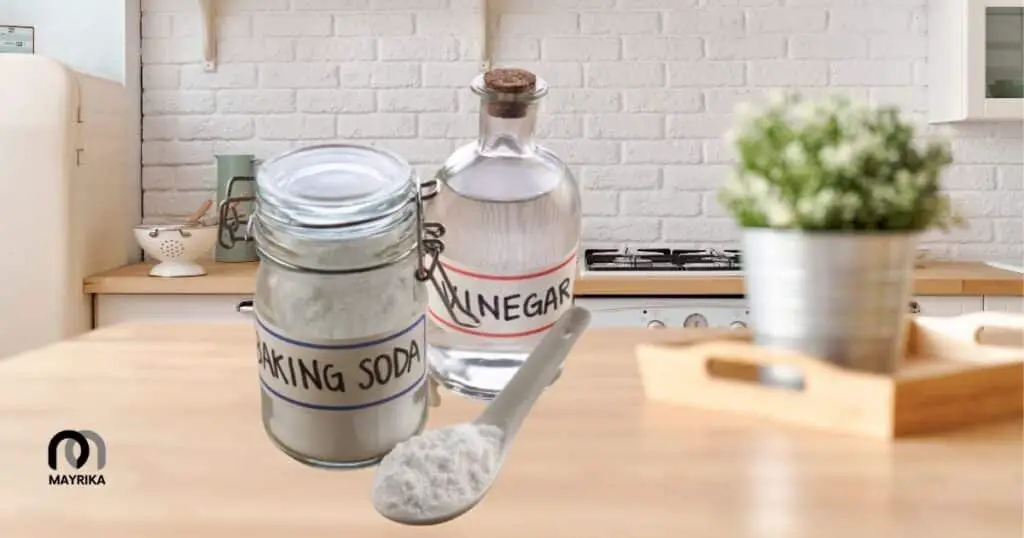
Let boil for 10 minutes, then let cool
Baking soda is a mild abrasive, so it can be used on soft and more rigid surfaces to rub them, making them less adherent. Vinegar is a base that will help neutralize acidity from soap/grime residue on your surface.
So, you’ll create this chemical reaction between the two (baking soda plus vinegar), which will produce bubbles because of the release of carbon dioxide gas depleted from the baking soda and water vapor generated by breaking off CO2 molecules from acetic acid in vinegar.
Let boil baking soda and vinegar for 10 minutes, then let cool.
Scrub with a sponge for cleaning the hard-anodized exterior
Okay, but there are those people who would say that it damages the surface. Anodized aluminum is a process where the substrate (aluminum) is electrolytically oxidized with both oxygen and reactive metal salts.
The anodic oxidation converts the metal to a thin film of aluminum oxide at the surface, which is several thousandths of an inch thick and micrometers in thickness at the outer layers, providing excellent corrosion resistance.
Scrubs damage this coating because they generate sparks that are hard on these materials.
Don’t get us wrong, scrubbing can be good for some surfaces like porcelain or stainless steel, but anything that has been anodized should only be cleaned with gentle dish soap and a sponge.
We would also recommend using a non-abrasive sponge rather than a dish scrubber brush to save wear and tear on your anodized exterior.
Rinse off all of the cleaning solutions – for higher-end brands: use their cleaner
High-end brands should have their cleaner and should say so on the can. However, yes, in theory, you can use any cleaner for these purposes.
If you’re trying to keep your anodized fixtures clean, then make sure that you’re using the correct cleaner for that type of fixture.
It might be more difficult than the general household-brand cleaner, but it will likely work better and last longer.
Important to remember is that cleaners should never be mixed without first consulting label instructions; improper mixes can result in chemical reactions which could destroy any or all coatings on your places and enable corrosion from metal ions within the cleaners.
Rinse off all of the cleaning solutions – for lower-end brands: use Bar Keepers Friend powder
The first thing we would recommend is to try the cheap solution. If you’re using a lower-end brand, Bar Keepers Friend powder can be used to remove any streaks by following the instructions on the packet.
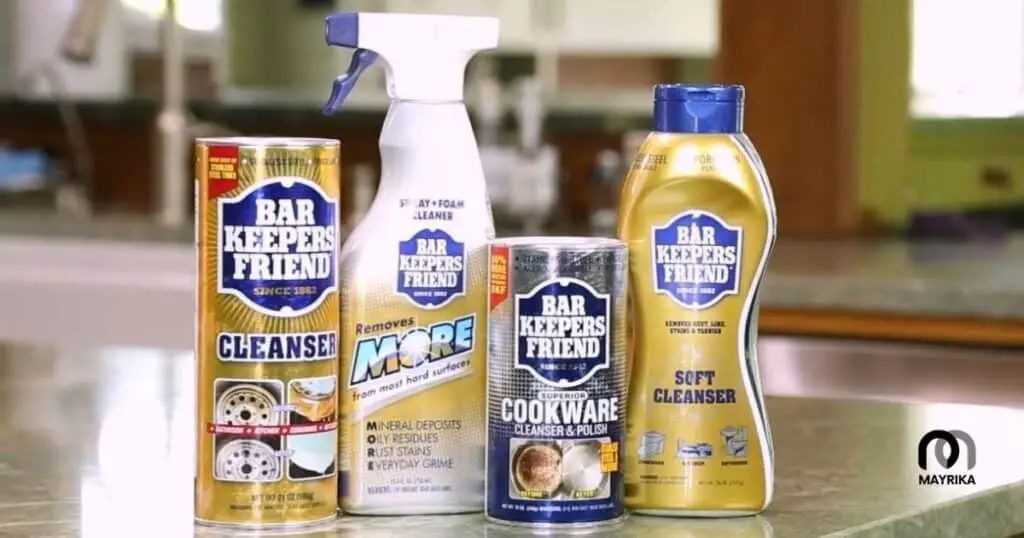
Polish with cooking oil
What are you trying to achieve? If your pot is already nice and glossy, the oil will give it a more incredible sheen. But if you want something deeper in color or a different finish, some things work.
Don’t use soap!!! Soap tends to leave bits of film on the surface and doesn’t do any good for its natural shine.
Olive oil, coconut oil, and grapeseed oil are all good for this. This is because these oils become slightly sticky with use and toughen up so they can be used to clean off any dirt or grime that remains after wiping with a rag.
With a little bit of patience and elbow grease, you should end up with a fantastic shine!
Avoid abrasive cleaners when cleaning hard anodized cookware exterior
Out of all cleaners, abrasive cleaners are used when you want things scrubbed clean.
While that’s the case, they’re too harsh for delicate surfaces like anodized cookware exterior because they can cause permanent scuffs, which will be felt on food once it comes time to use the pan.
It’s important to avoid abrasive cleaners when cleaning hard anodized cookware exterior.
How to clean hard anodized cookware interior?
Cleaning hard anodized cookware is a lot easier than you might think. It’s important to keep it clean if you want your food to taste good! Here are some quick tips for cleaning the inside of pots and pans.
- Fill the pot with water and add a small amount of dish soap, then place on a stovetop (with a lid on)
- Boil until bubbles come up from the bottom of the pan; remove from heat and let sit for 10 minutes after boiling ceases
- Remove from the stovetop, drain off the water, scrub with a sponge or cloth, and dry thoroughly
Hard anodized cookware is a great investment for any kitchen. As with all good things, it does require some upkeep to keep it looking and functioning at its best.
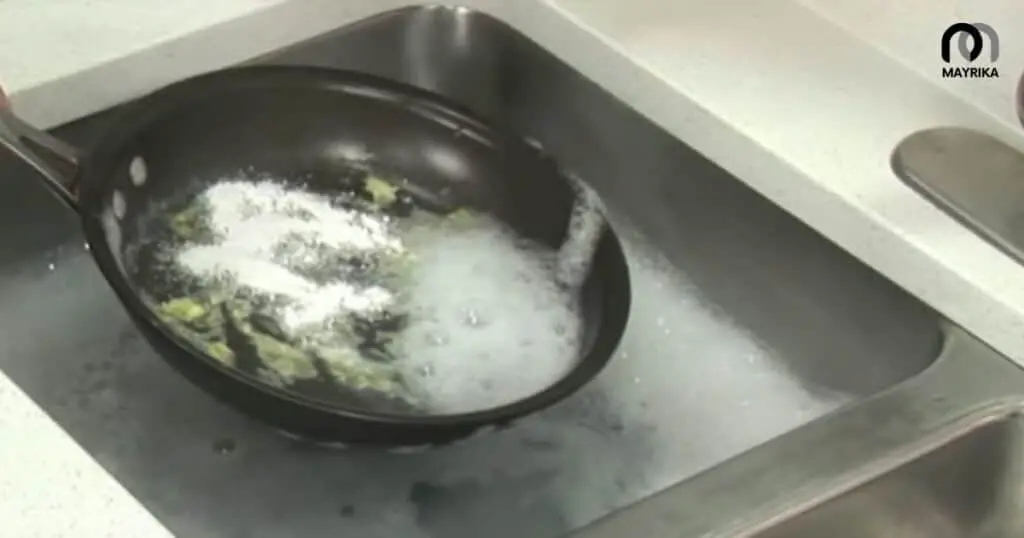
Using the right cleaner to clean hard anodized cookware interior
Pledge oil plus Dawn dishwashing soap. The majority of soaps are designed to break up oils, and that’s what anodized cookware is made out of.
Oils are fats that need to be taken care of with a good degreaser, like Dawn dishwashing soap or plain old dish detergent.
Combine the two with a bit of elbow grease, and you will have the best hard-anodized cookware cleaner out there!
Pledge Oil is made from high-quality pharmaceutical-grade maleic/olefinic type 1 synthetic ester, which produces an outstanding surface-active performance when used as a dry lubricant for moving metal parts or as a mild air-drying aerosol spray for the conveyor assembly areas.
Let your hard anodized cookware cool completely before you wash it
Let your hard anodized cookware cool completely before washing it is a clever response that will help prevent pitting. Pitting is where the surface of your anodized cookware has been eroded through etching!
Just as you might damage plexiglass by using harsh chemicals on it, you can pit the surface of anodized aluminum!
If the pot or pan gets hot enough with water (as from boiling water), droplets will vaporize and leave deposits on the pot’s surface.
Try waiting until your pots and pans have cooled down before wiping them out with a cloth. This will prevent damage to (even) hard anodized cookware.
Clean the hard anodized cookware interior with a sponge and dish soap
There are a couple of problems with this technique. And the first is that dish soap can sometimes damage anodized surfaces, so it’s best not to expose them to dish soap. Instead, use warm water and lots of elbow grease.
The other problem is that using a sponge might scratch, dull, or even mark up surfaces from abrasive scrubbing agents such as the steel wool included in Scrubbing Bubbles (which makes a good handle for the aforesaid sponge).
Lastly, when it comes time for cleaning up spilled food on your stovetop, then you’ll end up having to choose between damaging your new glossy top or executing an awkward reach across the edge; not always ideal for busy home cooks!
Clean the hard anodized cookware interior with scouring powders
Scouring Powders are more abrasive on the hard anodized surface than soap and water, so you may wish to avoid using them if you have a newer piece of cookware.
Some people have successfully used Scouring Powders to clean the hard anodized cookware interiors. Some people have not been successful in doing so.
The material of the surface could be another factor to consider when trying this strategy for cleaning. For example, stainless steel is a more forgiving material.
It can handle harsh chemicals, while hard anodized is very delicate and should only be cleaned with a non-abrasive sponge or cloth.
Hard anodized has been dampened slightly with water or a dish soap without any added scouring agents like bleach or ammonia due to their corrosive properties, which will damage the coating on the aluminum foil bottom of the pan.
Simmer hard anodized cookware in the water
When you are cooking food, two things cook the food. One is heated, and one is water content. Many people try not to let their food “drown” in too much water or spend a lot of time simmering it over high heat.
Because they think that too much liquid will cover up flavor, or the high heat will cause your dish to dry out quickly. Some people turn down the temperature and pour more liquid on top, so it creates more steam.
But actually, when you cook low to medium heat for a long time with plenty of liquid floating around, the natural flavors get extracted from your vegetables and meat into the simmering liquid, leaving behind delicious concentrated flavors at the end.
Research shows that aluminum, copper, and iron cookware produce toxic compounds such as acrylamide and heterocyclic amines.
So yes, it’s a good idea to do this with your hard anodized cookware. If your ceramic or stainless steel doesn’t have these metals in it, then there are no chemicals leaching into the food while the pan is simmering in water at a low temperature.
Clean hard anodized cookware with water and cream of tartar
The fastest way we found to clean anodized cookware is with water and cream of tartar mixture. It’s unbelievably easy, and you have to rinse it off right away.
Begin by filling a container with water and stir in 1-2 tablespoons of cream of tartar until dissolved. Add your soiled dish/pan to the solution, then let it soak for 5 minutes or more, depending on how dirty they are.
After soaking, use a sponge with a non-abrasive cloth (old t-shirt) to gently scrub the surface.
Avoid using cleaning solutions
It would be best if you didn’t use harsh alkaline cleaners on any cookware – anodized or not. These cleaners can cause damage and will generally be useless in really cleaning them.
They create a chemical barrier that is much more difficult to remove than other types of dishwashing detergent.
Avoid cleaning solutions that do not apply to hard anodized cookware. The harshest chemicals found in most dishwashing detergents are phosphates and chlorine bleach.
These two substances react with aluminum and cause a chemical reaction called “dissimilar metal corrosion.”
Over time this corrosion causes unattractive pitting or scratching of the surface. That’s why it’s important to check ingredient labels before buying cleaners for your hard-anodized cookware; keep them as gentle as possible.
Clean hard anodized cookware after each use
In that case, we would highly recommend cleaning your hard anodized cookware after each use.
This is because this type of cookware has aluminum as its base metal, and it’s important to clean it properly to preserve the quality of the cookware.
Rinse all food residue with warm, soapy water and rinse again. You may use a soft scrub pad if necessary.
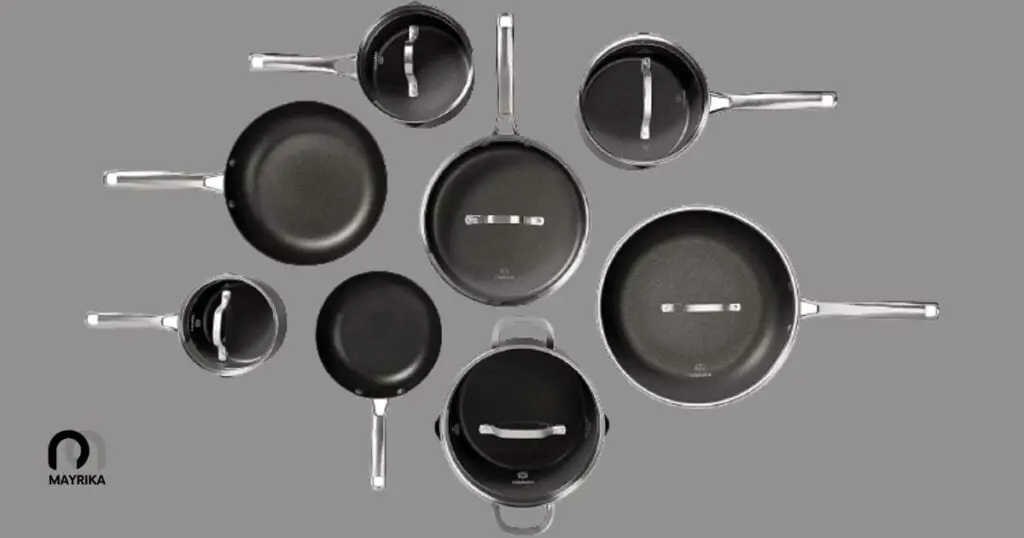
How do you care for hard anodized cookware?
If you’re going to wash your hard anodized cookware, allow it to cool first–otherwise, lukewarm water should do the trick just fine.
Make sure to hand-wash any cookware after using lemon juice, salt water, or other hard substances like raw egg whites.
If the cookware had tomato sauce or soup in the pan, clean as best as you can if you don’t want surfaces looking pitted and etched all over.
Rinse the pan so that there are no food particles on its surface, then add enough hot or warm water to cover its bottom surface area and about 1 teaspoon of dishwasher detergent for a typical 8-inch skillet, let soak for about an hour before washing with a sponge.
Wait until the rinse cycle to get rid of disposal odor such as garlic odor or onion smell.
How do you clean burnt hard anodized pans?
There are a few ways to try and get a burnt pan looking good as new. One option is to scrub it with baking soda, but vinegar or rubbing alcohol is another popular option.
Both household products can help remove the top layer of difficult-to-remove grease from the surface, reducing cleaning time.
The key here is just lots of elbow grease–rubbing the bowl with your hands will take off most of the more stubborn bits and pieces. There’s no need for fancy chemicals when you have enough determination!
How do you restore hard anodized cookware?
If the food is stuck in the cracks, you’ll need to soak the pots in soapy water to loosen them and use a nylon scrubber (like those used for washing pots) to take off any that’s left.
Be sure not to scratch or scrape at pans with strong abrasives, such as metal pads.
If there are dry food stains or discoloration from high heat cooking over time, wash them in hot, sudsy water with baking soda mixed in; this will clean up most of the dirt and odors on these surfaces without damaging your cookware.
We recommend using a non-abrasive cleanser for any tough scratches that weren’t removed by warm water soap.
Final words
Hard anodized cookware is a pain to clean. No matter how much you scrub the exterior and interior, there’s always going to be this thin film that washes off in your hands when you try to dry it with a towel.
The best way is using Bar Keepers Friend on hard-anodized pots and pans (You can also use Comet). It takes some elbow grease, but we find that after about 5 minutes of rubbing everything down with the powder, all the residue comes right off. With any luck, these tips will help make your life easier too!
The most effective way to clean hard anodized cookware both on the exterior and on the interior is to use warm water and a dishwasher-safe cleaner.
This should be done because it can remove stubborn stains from any anodized cookware that you have, as well as remove grease and other impurities from its surface.
We have a few easy tips to make the process less painful. First, always wash in warm water and never submerge them in cold water as this can damage the anodized coating inside your pots and pans.
Second, it’s best to avoid using steel wool pads when cleaning hard-anodized cookware exterior surfaces because they are abrasive enough that they may scratch off some of the surfaces if used too aggressively (although stainless steel scrubbing pads work well).
Finally, remember not to put anything over high heat without cooking oil.
Read Next: How To Use Parini Cookware?
FAQs
-
Can I use cooking spray on hard-anodized pans?
Most manufacturers recommend against using cooking spray on hard-anodized pans, although some people have had success with it.
-
Can I use steel wool on hard-anodized cookware?
Stainless steel wool or steel wool can scratch the surface of hard-anodized cookware.
-
How do I clean the outside of hard anodized cookware?
To clean the outside of hard anodized cookware, you can use a soft cloth and mild soap. It would help if you didn’t use abrasive cleaners, scouring pads, steel wool, or cleaners containing chlorine.
-
Is hard-anodized cookware easy to clean?
Hard-anodized cookware is more resistant to corrosion than standard aluminum and can be easily cleaned.
-
Can I repair scratched anodized cookware?
Scratches in anodized cookware can be repaired using metal polishing cream.
-
Do you need to season hard-anodized pans?
The anodized layer on hard-anodized cookware is nonporous and very durable, so you don’t need to season it. Seasoning is a process that uses oil to make the surface non-stick.
-
Does hard anodized coating come off?
Yes, a hard-anodized surface can be removed by using steel wool or the like.
-
What should the consumer use to clean a hard anodized pan?
When it comes to hard anodized cookware, there are a few things you should never use to clean it.
Some people might tell you that you can use oven cleaner or a comet to get your pans looking new again, but this is not true.
Both of these products will damage the surface of your pan and make it difficult to keep it clean in the future. The best way to clean a hard anodized pan is with gentle dish soap and some hot water.
You can also use a non-abrasive scrubber if there is any built-up food or grease on the surface of the pan.
Make sure to dry the pan thoroughly after cleaning, as any water left behind will cause corrosion and damage over time.
